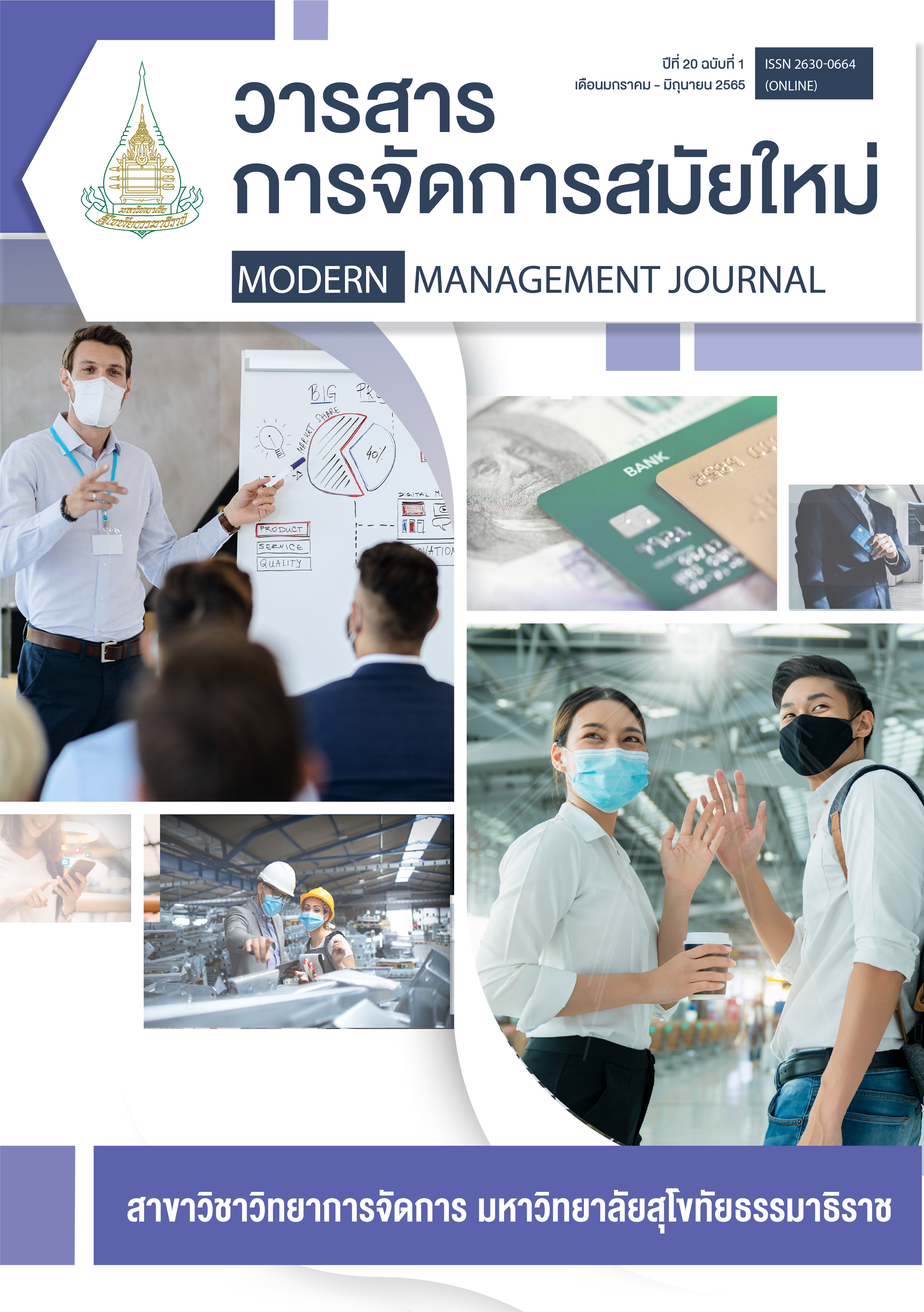รูปแบบการมีส่วนร่วมของสมาชิกในการจัดการธุรกิจแบบคลัสเตอร์ กรณีศึกษาคลัสเตอร์แฟชั่นและไลฟ์ไตล์ สภาอุตสาหกรรมแห่งประเทศไทย
คำสำคัญ:
รูปแบบการมีส่วนร่วมของสมาชิก , การจัดการธุรกิจแบบคลัสเตอร์ , คลัสเตอร์แฟชั่นและไลฟ์สไตล์บทคัดย่อ
การวิจัยนี้ มีวัตถุประสงค์เพื่อ 1) เพื่อศึกษารูปแบบการมีส่วนร่วมของสมาชิกในการจัดการธุรกิจแบบคลัสเตอร์ กรณีศึกษาคลัสเตอร์แฟชั่นและไลฟ์สไตล์ สภาอุตสาหกรรมแห่งประเทศไทย 2) เพื่อสังเคราะห์รูปแบบการมีส่วนร่วมของสมาชิกที่เหมาะสมในการจัดการธุรกิจคลัสเตอร์แฟชั่นและไลฟ์สไตล์ สภาอุตสาหกรรมแห่งประเทศไทย และ 3) เพื่อสังเคราะห์กลยุทธ์การมีส่วนร่วมของสมาชิกในการจัดการธุรกิจแบบคลัสเตอร์ การวิจัยเป็นวิจัยเชิงคุณภาพ เก็บรวบรวมข้อมูลโดยสัมภาษณ์กลุ่มกับสมาชิกที่เป็นคณะกรรมการบริหารกลุ่มอุตสาหกรรม 9 กลุ่ม จำนวน 36 ตัวอย่าง นำผลการสัมภาษณ์มาสังเคราะห์รูปแบบการมีส่วนร่วมของสมาชิกด้วยการใช้การวิเคราะห์เนื้อหาหลักตัวแบบเพชร ตัวแบบ SWOT Analysis และ TOWS Matrix Analysis และผลการสังเคราะห์ไปเสนอต่อที่ปรึกษาคลัสเตอร์เพื่อหารูปแบบที่เหมาะสม
ผลการวิจัยพบว่า 1) รูปแบบการมีส่วนร่วมของสมาชิกในการบริหารกลุ่มธุรกิจมาจากระบบตัวแทนกลุ่มอุตสาหกรรม และเลือกหนึ่งในสมาชิกเป็นคณะกรรมการบริหารคลัสเตอร์ตามข้อบังคับของสภาอุตสาหกรรมแห่งประเทศไทยซึ่งมีหน้าที่รับผิดชอบในการจัดกิจกรรม วาระการประชุม และแจ้งให้สมาชิกทั่วไปมีส่วนร่วมในกิจกรรมกลุ่ม 2) จากการสังเคราะห์รูปแบบการมีส่วนร่วมของสมาชิกที่เหมาะสมในคลัสเตอร์แฟชั่นและไลฟ์สไตล์ พบว่า การมีส่วนร่วมของสมาชิกคลัสเตอร์ถูกจำกัดจากข้อบังคับของสภาอุตสาหกรรมแห่งประเทศไทย ในขณะเดียวกันสมาชิกมีโอกาสที่จะแสวงหาความร่วมมือระหว่างอุตสาหกรรมเองตามความเหมาะสมและความสัมพันธ์ภายในห่วงโซ่อุปทาน และ 3) จากการสังเคราะห์กลยุทธ์การมีส่วนร่วมของสมาชิกในการจัดการธุรกิจคลัสเตอร์ พบว่า ประกอบด้วยกลยุทธ์ย่อย 4 กลยุทธ์ ได้แก่ กลยุทธ์เชิงรุกเน้นการมีส่วนร่วมในกิจกรรมซัพพลายเชนและกิจกรรมส่งเสริมผลิตภัณฑ์คลัสเตอร์กับภาครัฐ กลยุทธ์เชิงรับเน้นการมีส่วนร่วมในกิจกรรมการแสวงหาตลาดใหม่และการเจรจากับสถาบันการเงินทั้งภาครัฐและเอกชน กลยุทธ์เชิงแก้ไขเน้นการมีส่วนร่วมกับรัฐบาลในการเจรจาเพื่อแก้ไขสิทธิพิเศษทางการค้ากับประเทศคู่ค้าและกลยุทธ์เชิงป้องกันเน้นการมีส่วนร่วมในการค้นหาแหล่งวัตถุดิบใหม่และเสนอโครงการทางธุรกิจเพื่อขอรับทุนจากรัฐบาล
References
American Public Transportation Association. (2019). The Role of Transit in Support of High Growth Business Clusters in the U.S. สืบค้น 3 กันยายน 2562 จาก https://www. apta.com/ wp-content/uploads/Resources/resources/ reportsandpublications /Documents/ TransitHighGrowthClustersUS-Final2013-1124-1.pdf
Asian, I., Kumpikaite, V. and Cinar, O. (2012). Creating strategies from tows matrix for strategic sustainable development of Kipaş Group. Journal of Business Economics and Management Vol. 13(1), pp. 95-110.
Bell, M. & Albu, M. (1999). Knowledge Systems and Technological Dynamism in Industrial Clusters in Developing Countries. World Development, Vol. 27, Iss. 9 pp. 1715-1734.
BOP Consulting (2017). The East London Fashion Cluster. Draft Strategy and Action Plan, February 2017.
Cohen, J.M., & Uphoff, N.T. (1977). Rural Participation: Concepts and Measures for Project Design, Implementation and Evaluation. In Rural Development Monograph No.2 The Rural Development Committee Center for International Studies, Cornell University, January.
Cohen, J.M., & Uphoff, N.T. (1980). Participations place in rural development: Seeking clarity through specificity. World Development Vol. 8 (3), pp. 213-235.
Giuliani, E. (2005). Cluster Absorptive Capacity: Why Some Clusters Forge Ahead and Others Lag Behind? European Urban and Regional Studies Vol. 12, Iss.3. PP.269–88.
Inter-American Development Bank. (2017). Cluster in the Caribbean. สืบค้น 30 กันยายน 2562 จาก
https://pdfs.semanticscholar.org/ea7a/77c86e15c61fcbc46f0bef11e8f 3fce79b64.pdf.
JP Morgan Chase & Co. (2015) Accelerating Cluster Growth: A Playbook for City Leaders. Executive Summary, June 2018)
Khatsenko, E., S. (2019). The Sustainability of Cluster Business Structure in a Crisis. Voprosy Regionalnoj ekonomiki Vol. 39 (2) pp. 96-100
Kulshrestha, S. & Puri, P. (2017). Tows Analysis for Strategic Choice of Business Opportunity and Sustainable Growth of Small Businesses. Pacific Business Review International Vol. 10 Iss. 5. pp. 144-152.
Lyon, F. & Atherton, A. (2000). A Business view of Clustering: Lessons for Cluster Development Policies. University of Durham. Foundation for SME Development.
Manicham, A., R., S. (2016). Future of Cluster Development-Lessons from Energy Valley, The Netherlands. A thesis of London South Bank University for the degree of Doctor in Philosophy.
Malta Enterprise. (2014). Cluster in Business สืบค้น 12 มิถุนายน 2562 จาก https://www.maltaen terprise.com/sites/default/files/clusters.pdf
Maxwell Stamp Plc. (2013). Support to Cluster Development in Croatia: Cluster Development Handbook สืบค้น 12 ธันวาคม 2562 จาก https://www.enterprise-development.org/wp-content/uploads /GuidelinesforClusterDevelopment.pdf
Mefford, C. (2010). Washington State Fashion and Apparel Industry Cluster Study. Community Attributes International.
National Institute of Economic and Social Research. (2017). Industrial Clusters in England. London: Department for Business, Energy & Industrial Strategy.
Porter, Michael E. (1998) Clusters and the New Economics of Competition Documentation. Harvard Business Review, Boston.
Schmitz, H. & Nadvi, K. (1999). Clustering and Industriakization: Introduction. World Development, Vol. 27, Iss. 9 pp. 1503-1514.
Swansburg, R. C. (1996). Management and leadership for nurse managers, 2nd edition. Boston: Jones and Bartlett.
The U.S. Agency for International Development (USAID) (2003). Software/ICT Cluster Vietnam Competitiveness Initiative (VNCI). Hanoi, Vietnam.
Wheelen, L., T. and Hunger, D., J. (2012). Strategic Management and Business Policy toward Global Sustainability, 13th edition. Boston: Pearson Education, Inc.
World Bank. (2004). Development and Poverty Reduction: Looking Back, Looking Ahead, The World Bank, Washington 2004
Zhang, Z., To, C. & Cao, N. (2004). How do Industry Cluster Success: A Case Study in China’s Textiles and Apparel Industries. Journal of Textile and Apparel, Technology and Management, Vol. 4, Iss. 2 pp. 1-10.
Downloads
เผยแพร่แล้ว
How to Cite
ฉบับ
บท
License
Copyright (c) 2022 วารสารการจัดการสมัยใหม่

This work is licensed under a Creative Commons Attribution-NonCommercial-NoDerivatives 4.0 International License.


